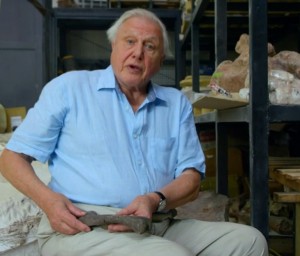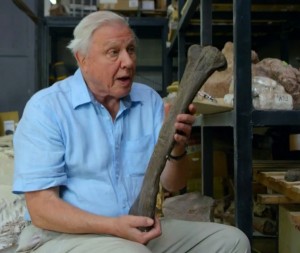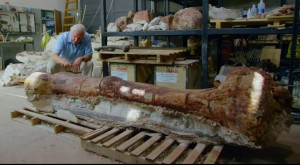Attenborough and the Giant Dinosaur
When introducing us to a long-dead ancestor then who could be better suited than David Attenborough and the Giant Dinosaur.
Patagonia in southern South America when, a few years ago, a man looking for one of his lost sheep found a simply gigantic bone sticking out of a rock. – a bone that was going to astonish science. That first bone led to the discovery of over 200 others.
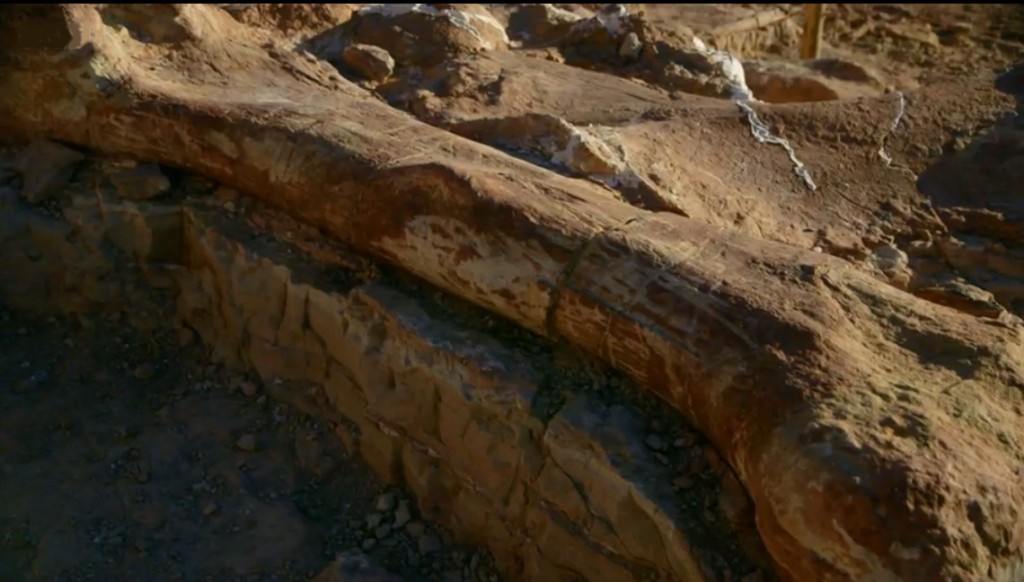
These bones were part of a skeleton that had remained hidden and marvellously preserved for 100 million years. An international team of scientists assembled to try and work out what sort of dinosaur it belonged to. Could it really have been the biggest animal to have ever walked the earth?
Like many detective stories, this one began by chance. A shepherd stumbled across the tip of a huge bone poking out of the ground. Experts from Patagonia’s premier palaeontological museum confirmed it was part of a giant dinosaur. But they didn’t realise at the time what a truly extraordinary one it would prove to be.
Dinosaurs of many kinds roamed all over these lands on the southern end of South America during what’s known as the Cretaceous period, between 66 and 145 million years ago. The largest were plant-eaters known as sauropods. And the largest of them were the titanosaurs.
Giant titanosaur bones are comparatively rare so very little is known about these dinosaurs. This new discovery could change all that.
The first sauropods to appear on earth were comparatively small creatures. This is the cast of the thigh bone of one of them. It’s not even as big as my thigh bone. But after about 20 million years, some had become pretty big.This is the thigh bone from one of those creatures. But then, after that… our giant appeared. This is its thigh bone. It’s the largest ever found.
Alba Maio – Farmer
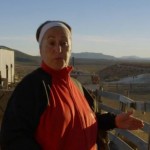
Coming across such a bone in your backyard must be quite a shock. Just ask farm owner Alba Maio.
Alba Maio “I don’t have many sheep but I do have dinosaurs! We’re surprised and shocked. Apparently it’s a unique specimen because of its size.”
Before long the whole team of fossil-hunting scientists arrives and starts work. The thigh bone proves to be eight feet, 2.4 metres long. It’s preserved in extraordinary detail, and detail will be critical to the forensic examination that will follow.
The research team soon turn the site into a vast quarry. It proves to be one of the biggest dinosaur finds of the century. Bone after bone emerge from the rocks.
Until recently, giant titanosaurs have only been known from a dozen bones and our team have already found more than ten times as many.
Dr Diego Pol – Palaeontologist
Dr Diego Pol is the chief palaeontologist leading the investigation.

Dr Diego Pol “If you really want to know what a really gigantic dinosaur looked like, this quarry here has the potential to answer that question and that’s really exciting for us. It’s really impressive. When you stand by one of these bones, you really feel tiny.”
With so much new evidence, there is a chance of discovering all kinds of new facts about our mysterious giant dinosaur.
Dr Diego Pol “It’s like a palaeontological crime scene. It’s a really unique thing that you will not find anywhere else in the world.”
Patagonia’s harsh weather makes uncovering the fossil exhausting, but it also endangers the newly-exposed fossils.
Dr Diego Pol “A lot of damage from the rain so we need to protect the bones that are at risk. I’m really concerned that this already has some cracks.”
If the bones aren’t protected, tiny details on their surface could be lost. To protect the bones, they’re covered with, of all things, wet toilet paper and plaster of Paris. It’s like putting a plaster cast on a broken leg. There’s a rush to get them back to the museum to begin examining them in minute detail. A new road has been specially built to enable them tp be transports without too much jolting.

Once at the museum laboratory, the detailed detective work begins. It’s a chance to start putting flesh on bones.
Dr Diego Pol “Some really big muscle was going in here. This animal was so big that it certainly needed really powerful muscles and very strong attachments into the bones.”
This is a giant vertebra, one of the bones in the spine, and it’s a very important find. That’s because it’s likely to provide crucial evidence for identifying the species of our dinosaur. Despite weighing up to half a tonne, these fossils are surprisingly fragile.
Many more weeks of detailed examination will be needed before the backbones reveal all their secrets.
Surprisingly, one of the first things our team was able to deduce about our titanosaur is its weight. That’s because, after finding the thigh bone, they discover another huge bone from the front leg- a humerus. By measuring the circumference of each of these leg bones, it’s possible to estimate how much weight they could support.
Dr Jose Luis Carballido

Dr Jose Luis Carballido “Yeah, around 70 tonnes or even more, probably.”
That evening, Dr Jose Luis Carballido checks his calculations.
Dr Jose Luis Carballido “I’ve been calculating how heavy the dinosaur was.It weighed more than Argentinosurus!”
Until now, Argentinosaurus was the heaviest known dinosaur. Ours already looks bigger. Could this mean it was the largest animal ever to walk the earth? Could it also be a new species? We can’t be sure… yet. What is certain is that this was a giant dinosaur.
